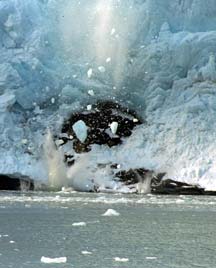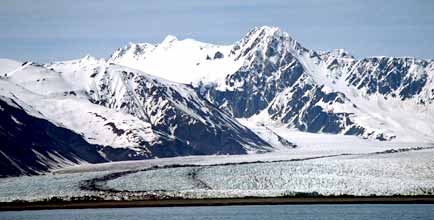Glaciers in Alaska
Icefields and an estimated 100,000 glaciers cover 5 percent
of Alaska's surface and they are easily viewed by visitors to
Juneau, Valdez, Whittier, Seward,
Anchorage or the Matanuska Valley. Cruises that take visitors
close to the face of tidewater glaciers offer visitors the opportunity
of watching them calve icebergs into the sea.
 Columbia
Glacier, one of the largest tidewater glaciers in
the state, can be viewed from boats departing from Valdez or
Whittier, or from a water taxi or helicopter based in Valdez. A terminal moraine keeps boats some distance from
the glacier's face. The glacier can also sometimes be seen from
the air on flights between Seattle or Juneau and Anchorage.
On flights north, request a window seat on the right side of
the plane. Columbia
Glacier, one of the largest tidewater glaciers in
the state, can be viewed from boats departing from Valdez or
Whittier, or from a water taxi or helicopter based in Valdez. A terminal moraine keeps boats some distance from
the glacier's face. The glacier can also sometimes be seen from
the air on flights between Seattle or Juneau and Anchorage.
On flights north, request a window seat on the right side of
the plane.
The Harding Icefield in
Kenai Fjords National Park covers
300 square miles. Its tidewater glaciers can be viewed from
tour boats that depart from Seward's small boat harbor.The face
of an inland glacier, Exit Glacier, can be approached on trails from a parking lot at the end of Exit Glacier Road, which intersects
the Seward Highway just north of Seward.
Portage Glacier. Several
hanging glaciers can be observed in the mountains surrounding
the community of Girdwood, which is about a 45-minute drive
along the Turnagain Arm of Cook Inlet from Anchorage. Another
10 minutes takes you to Portage and the turnoff to Portage Glacier.
Two hanging glaciers – Explorer Glacier and Middle Glacier
– can be seen at the right during the six-mile drive to
the Begich, Boggs Visitor Center beside Portage Lake. Portage
Glacier has begun to recede from the further shore of Portage
Lake although much of its face still extends 100 feet down into
the lake. It is most easily seen nowadays from a cruise boat
on the lake. Burns Glacier, a hanging glacier just to the left
of Portage Glacier, can be seen from the visitor center and
is often mistaken for Portage Glacier. Nearby Byron Glacier
can be hiked to from a parking lot just off the road between
the visitor center and the boat launch building.
Mendenhall Glacier, just
north of Juneau, is the most accessible of the glaciers in the
1,500-square-mile Juneau Icefield. It can be reached on the
Glacier Highway. Other glaciers in the area can be viewed on
boat or flightseeing tours or by helicopter.
Glacier Bay National Park and Preserve,
about 50 miles from Juneau, includes 12 tidewater glaciers that
calve icebergs into the bay. Visitors can arrange a boat tour
from Juneau or a flight to the airport at Gustavus, the gateway
community for the park. It is the largest water-area park in
the United States. The National
Park Service site for the park has detailed visitor information.
Malaspina Glacier is the
largest glacier in the state, with an area of 1,500 square miles
and extending 50 miles from Mount St. Elias toward the Gulf
of Alaska.
Matanuska Glacier is
a 27-mile-long glacier that is an easy two-hour drive from Anchorage
on the Glenn Highway. There are good views of the glacier from
the highway and from the Matanuska Glacier State Recreation
Site. A privately owned park allows visitors to hike to the
four-mile-wide face of the glacier.
|

 Columbia
Glacier, one of the largest tidewater glaciers in
the state, can be viewed from boats departing from Valdez or
Whittier, or from a water taxi or helicopter based in Valdez. A terminal moraine keeps boats some distance from
the glacier's face. The glacier can also sometimes be seen from
the air on flights between Seattle or Juneau and Anchorage.
On flights north, request a window seat on the right side of
the plane.
Columbia
Glacier, one of the largest tidewater glaciers in
the state, can be viewed from boats departing from Valdez or
Whittier, or from a water taxi or helicopter based in Valdez. A terminal moraine keeps boats some distance from
the glacier's face. The glacier can also sometimes be seen from
the air on flights between Seattle or Juneau and Anchorage.
On flights north, request a window seat on the right side of
the plane.